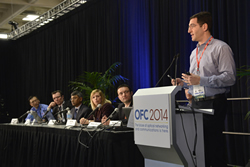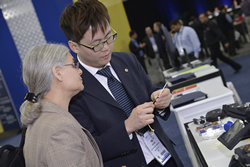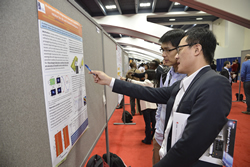PRESS RELEASE
14 March 2014
Day 5: Thursday, March 13 - Final Day of OFC Includes Market Watch Program, Poster and Tech Sessions, Post-Deadline Papers and More
Attendees got their last taste of OFC 2014 with yet another full day of show floor programming, tech sessions and events.
Market Watch Explores Pluggable Optics and Silicon Photonics’ Potential
 In the exhibit hall, programming continued with Market Watch, the Plastic Optical Fiber Symposium and panels on optical layer flexibility and passive optical LAN. At the Market Watch Panel on 100G/400G Pluggable Optics, experts from Finisar, ClariPhy, NTT and others discussed various high-speed pluggable optics, such as CPAK, CFP2, CFP4, QSFP28, CXp, which are in high demand for the 100G to 400G era. Robert Blum of Oclaro noted that “next generation 100 and 200G coherent pluggable transceivers are in the sampling stage now,” while panelist Mitch Fields of Avago expanded on the networking options available today, noting that power limits the functionality of pluggables and advanced functionality in pluggables does not address the needs of modern data centers.
In the exhibit hall, programming continued with Market Watch, the Plastic Optical Fiber Symposium and panels on optical layer flexibility and passive optical LAN. At the Market Watch Panel on 100G/400G Pluggable Optics, experts from Finisar, ClariPhy, NTT and others discussed various high-speed pluggable optics, such as CPAK, CFP2, CFP4, QSFP28, CXp, which are in high demand for the 100G to 400G era. Robert Blum of Oclaro noted that “next generation 100 and 200G coherent pluggable transceivers are in the sampling stage now,” while panelist Mitch Fields of Avago expanded on the networking options available today, noting that power limits the functionality of pluggables and advanced functionality in pluggables does not address the needs of modern data centers.
Market Watch concluded with a panel on the merits of PIC vs. Silicon Photonics, with participants discussing whether silicon photonics will live up to its hype and find a bonafide place in the market. Most panelists said yes – PICs are in the marketplace right now and silicon devices are in the transceiver modules with the potential for further market application, especially in data centers and high-performance computing. Mehdi Asghari of Mellanox said that persistent investment is needed to build up the manufacturing infrastructure for silicon devices—enabling it to go into automated processing and assembly. Geoff Bennett of Infinera noted that silicon photonics devices are price-dominated while Indium Phosphide PICs are noise and performance-dominated. Chris Doerr of Acacia reviewed the pros and cons of PICs vs. silicon photonics and concluded, in some contrast to the other speakers, that Metro is the “sweet spot” for silicon.
550 Exhibitors Shape the Conversation
 The exhibiting companies on the show floor were treated to an exhibitor appreciation breakfast this morning, where organizers touted the importance of their representation to the show as a whole.
The exhibiting companies on the show floor were treated to an exhibitor appreciation breakfast this morning, where organizers touted the importance of their representation to the show as a whole.
“This year's tradeshow continued to grow at a healthy pace and all of the exhibitors I spoke with this week were excited about the level of engagement and traffic on the exhibit floor here in San Francisco,” said Melissa Russell, OFC’s Chief Industry Relations Officer. “With a solid and expanding base of attendees from all sectors of the communications market—from data center end users and service providers and carriers, to systems and component vendors—the show represents the entire supply chain and truly provides a marketplace where the industry learns, connects, networks and closes deals. The vast majority of exhibitors will be back next year for OFC 2015 in Los Angeles and we're grateful for the ongoing support of so many communications industry companies that make OFC such a vibrant world-class event.”
At the breakfast for exhibitors, OSA Senior Industry Advisor Tom Hausken gave a market overview—providing an overarching view of current and future market projections in optical communications and covering key drivers over the next decade. “We’re at an inflection point in the industry,” he said. He explained how consumer-based companies such as Google, Amazon and Apple are “the most innovative companies in optics and photonics today. We’re at a new age of optics. Some of it is opportunity and some of it is disruption.”
Tech Presentations Wrap Up with Standing-Room Only Sessions
 The Poster Sessions were underway for the third and final day on the show floor. Attendees heard presentations on topics in the areas of optical network architecture, optoelectronic devices, digital transmission systems, access networks and others. Technical attendees heard from an IBM research team today that announced a new record for data transmission over a multimode optical fiber—sending data at a rate of 64 Gb/s over a cable 57 meters long using a VCSEL. The rate was 14 percent faster than the previous record and 2.5 times faster than the capabilities of today’s commercial technology. The achievement demonstrated that the standard, existing technology for sending data over short distances should be able to meet the growing needs of servers, data centers and supercomputers through the end of this decade, the researchers said.
The Poster Sessions were underway for the third and final day on the show floor. Attendees heard presentations on topics in the areas of optical network architecture, optoelectronic devices, digital transmission systems, access networks and others. Technical attendees heard from an IBM research team today that announced a new record for data transmission over a multimode optical fiber—sending data at a rate of 64 Gb/s over a cable 57 meters long using a VCSEL. The rate was 14 percent faster than the previous record and 2.5 times faster than the capabilities of today’s commercial technology. The achievement demonstrated that the standard, existing technology for sending data over short distances should be able to meet the growing needs of servers, data centers and supercomputers through the end of this decade, the researchers said.
Highly Competitive Post-Deadlines Showcase the Latest and Greatest Research
OFC’s eagerly anticipated post-deadline paper session was the final event of the evening, featuring the most recent high-impact results in optical communications research. OFC 2014 program co-chairs noted that trends in this year’s papers include software-defined networking, silicon photonics and space-division multiplexing (SDM). A paper from a team in Japan and Denmark showed an impressive demonstration of SDM using the combination of multicore fiber with 12 cores with three modes in each core. The key advance is that it puts much more capacity over a single fiber by using not just more than one core in the fiber but also multiple modes within each fiber. Thus with three modes in each of 12 cores, capacity theoretically improves by 36 times.
After a week of workshops, panels, technical sessions, exhibits, networking and more, OFC wrapped up on a high note with increased attendance, exhausted (but satisfied) attendees and momentum going into next year’s show, taking place March 22 – 26, 2015 in Los Angeles.